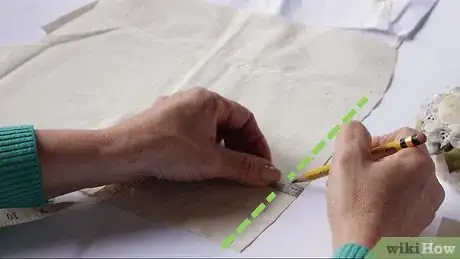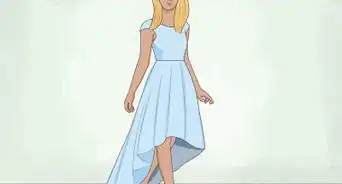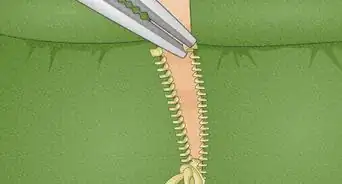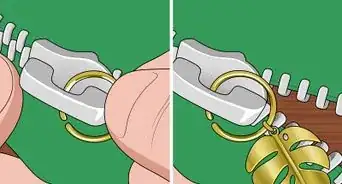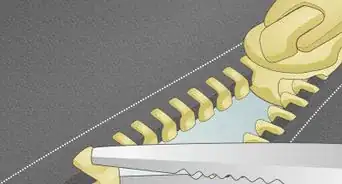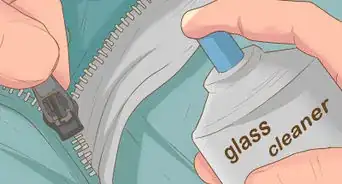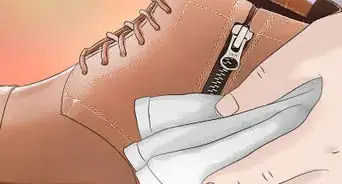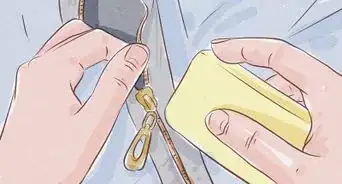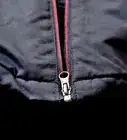This article was co-authored by Kpoene Kofi-Bruce. Kpoene Kofi-Bruce is a tailor, couture wedding gown designer, and the Creative Director of Mignonette Bridal and Ette the Wedding Tailor in Chicago, Illinois. With nearly two decades of experience as a wedding gown designer, small business owner, and vintage sewing enthusiast, Kpoene specializes in wedding gown design and the social history of wedding dresses. She received a BA in Creative Writing from Middlebury College and studied the business of fashion at the Fashion Institute of Technology. She is also a graduate of the Goldman Sachs 10KSB program and the Chicago Fashion Incubator and has written about wedding fashion for Jezebel, Catalyst, the Sun Times, and XO Jane.
There are 8 references cited in this article, which can be found at the bottom of the page.
This article has been viewed 112,166 times.
Zipper-flies are very popular in ready-to-wear clothing. If you have basic sewing supplies, a fly zipper, and a pattern for a skirt or a pair of pants, you should be able to sew a fly zipper with a little patience. Take your time and, when necessary, consult your pattern. While most people can install a fly zipper with some dedication, the process can be a bit complicated if you're doing it for the first time.
Steps
Preparing the Front of the Skirt or Pants
-
1Figure out your fabric's direction. All fabric has a direction, which refers to how the grain line of the fabric moves. When cutting your fabric, you want to make sure you're cutting in the direction of the grain line. If you're not, this could result in a tight, ill-fitting final product.[1]
- Stretch out either end of your fabric. One end of fabric should stretch out slightly further.
- The side that stretches further is your fabric's direction. You'll want to cut in the direction of the stretcher side when cutting your fabric.
-
2Cut your pants fronts. With a fly zipper, you'll need to sew it into two matching pieces of fabric.[2] These pieces of fabric make up the front of your pants or skirt. You should use a pattern here, especially if you're new to sewing. The precise size you'll need will depend on your measurements, or the measurements of the person who you're making the outfit for.[3]
- On a fly zipper, each pant front has an outward flap. This is a small, somewhat rectangular curved portion of fabric that sticks out from the edge of the pant fronts. You will sew the zipper into these flaps, as they will eventually form the fly of the pants.
- Your pants fronts will essentially be two rectangles of equal size. Each rectangle will have one outward flap. The flaps should also be of equal size. One rectangle should have an outward flap on the top right corner. The other should have an outward flap on the top left corner.
Advertisement -
3Mark the seam on each pant front. You will want to sew the two pant fronts together. You will be sewing together the sides containing the outwards flaps. Consult your pattern here. The seam line should be drawn about half an inch into the pant flap, leaving some overlap between each flap. The precise overlap depends on your pattern's requirements.[4]
- Use a pen to draw the seam line. Make sure you draw the line on the backside of the fabric. This is the side of the fabric that will face your body when you wear the outfit. It is usually a duller color than the front side of the fabric.
- The seam line is a straight line that runs along the long side of each pant front. Use a ruler to keep your seam line as straight as possible.
-
4Mark where the sewing line ends and the basting line begins. You want to baste a certain portion of the seam line. You baste this portion as basting stitches can be undone easily. The basting line will be removed once the fly zipper is installed.[5]
- You will start sewing at the bottom of the pant fronts and sew upward towards the outward flaps. At a certain point, you will stop sewing and begin basting.
- Consult your pattern to see how many inches you sew upward before you begin basting. Find the point where you begin basting with a ruler and mark it with a pen. You can mark the beginning of the baste line with a dot, a horizontal line, or another marking of your choosing.
-
5Line up the front pieces. Take your two front pieces. Place them on top of one another, with the front sides of the fabric touching. Make sure you line up the front pieces so they're matching. If you look at your lined up front pieces from above, they should look like a single piece of fabric.[6]
-
6Stitch down the seam until you reach the end of the basting line. Start at the bottom of the seam line. Do regular sewing, preferably using a sewing machine, until you reach the marker that indicates you've reached the basting line.[7]
- Make sure to use the same color thread as the fabric you're using. If you don't have the right color handy, go one shade darker rather than one shade lighter. This will look less awkward when you complete the project.[8]
- Once you reach this marker, you'll want to backstitch slightly. This means you'll sew backward for an inch or so, sewing over the stitches you've already made.
-
7Continue to the top with a basting stitch. Once you've reached the baste line, switch to a basting stitch. Continue basting until you reach the top of the pant fronts. A basting stitch is a light, simple stitch that can easily be undone.[9]
- To do a basting stitch, you sew in a straight line and weave the needle in and out of the fabric. Press the needle through the underside of the fabric and pull it out onto the upper side. Then, move the needle forward about half an inch.
- Push the needle through the upper side of the fabric and pull it out onto the underside. Try to keep the space between stitches as even as possible as you work.
- Repeat this process until you've reached the top of the basting line. A basting stitch should look like a dotted line running along the fabric.
Placing the Zipper for Sewing
-
1Press the seam open. Once your pant flaps are sewn together, spread them apart. This is sort of like opening a book or newspaper. When spread apart, the pant fronts should form a rectangular shape. Place the now connected pant fronts on a flat surface, with the underside of the fabric pointed upward. You will notice the outward flaps have spread apart to form a circular shape on the top of the pant fronts. You should also notice the seam.[10]
- Remember, the seam line was drawn about half an inch into each pant front. Two strips of fabric should be pressed against each other, running down the center of the connected pant fronts to form a vertical line.
- You'll want to separate these strips of fabric. Like spreading the pant fronts apart, this is like opening a book or newspaper. When you've separated the strips, flatten them against the pant fronts.
- When you're finished, there should be two rectangular strips of fabric side-by-side that run down the center of the connected pant fronts.
-
2Line the zipper up with the basted seam. Take your zipper tape and place it on the top of your pant fronts. The zipper tape should lie on the left outward flap. The right side of the zipper tape should line up with the basting line.[11]
- The actual zipper handle, found on the end of the zipper line, should not be on the edge of your pant fronts. You'll eventually add a waistline to your pants, where you'll likely add a button.[12]
- There should be a few inches of loose zipper line between the end of the pant fronts and the zipper's handle.
-
3
-
4Fold the pant fronts out of the way. Grab onto the left outward flap. This is the outward flap to which the zipper line is now pinned. Pull the outward flap upward. Then, press the pant fronts together, like you did when you initially sewed them. The pant fronts should be on top of one another, with the left outward flap sticking out to the left. You want to separate this outward flap from the actual pant fronts so you can sew the zipper into this flap.[15]
Sewing in the Fly Zipper
-
1Sew the left side of the zipper line into the left outward flap. From here, you'll want to begin the process of sewing the zipper to your pants. You'll want to first sew the left side of the zipper line onto the outward flap. This should be the side of the zipper line closest to the curved outward flap. Do not sew the side of the zipper line closest to the pant fronts.[16]
- Sew the zipper onto the outward flap by sewing the length of the basting line.
- Start at the bottom of the zipper line and work your way up to the top.
-
2Fold the pant fronts in half. Pull the zipper line upward. Fold the pants fronts in half, dividing them by the zipper line. The idea here is to get the bulk of the fabric out of the way so you're just targeting the zipper and a small portion of pant fabric when you sew next. You should be left with a rectangular shape of layered fabric, with the zipper line sticking out its left side.[17]
-
3Run some stitches down the fold near the zipper line. A small amount of fabric should be folded over the right side of the zipper line. Along this fold of fabric, you will see one of the basting lines you originally drew. Sew along this fold, following the basting line. This will help secure the zipper in place further.[18]
-
4Move the right flap outward and lie the flaps flat on a table. From here, reach underneath the folded fabric. You should feel the right outward flap. Move this flap out from under the folded portion of fabric. Lie it flat against the table.[19]
-
5Sew the right end of the zipper line to the right flap. Pin the zipper line onto the right outward flap. Then, sew the right side of the zipper line into the right outward flap. Once again, sew the zipper line on the side facing the outward flap.[20]
Completing the Fly Zipper
-
1Pin down your layers. Unfold the skirt. Lie it flat on the table, this time having the front side of the fabric facing upward. Use your fingers to feel where the zipper tape runs down the underside of the fabric. Pin all the layers of the skirt together in a line that runs down the zipper line.[21]
-
2Draw a top stitching line on the front side of your fabric. When sewing a fly zipper, there is a line called the top stitching line. This is a line on the front side of the fabric you need to stitch. Consult your pattern to find where to draw your top stitching line.[22]
- If you're not following a pattern, the top stitching line mirrors the shape of the left outward flap. You can feel for where the flap falls with your fingers, and trace its outline using a fabric pen.
- Make sure to choose an erasable fabric pen to draw this line. This portion of the skirt will be visible, so you want a line you can remove later.
-
3Sew along this line. Take a needle and thread. Starting at the top, sew along the top stitching line. Sew until you feel the edge of the zipper line. Stop here.[23]
-
4Undo your basting stitches. You're almost done. Once you've sewn the stitching line, all you have to do is remove the basting stitches you made when first sewing the pant fronts together. You can use a tool called a seam ripper, which you can purchase at any craft store.[24]
- Gently slip the seam ripper below each stitch on the basting line. Pull the stitches until the thread breaks. Then, remove any excess bits of thread with your fingers. You may have to use a pair of scissors to trim any lingering thread still stuck to the fabric.
- You should now have a fly zipper securely sewed to your pant fronts. The fly on your pants will be completed.
Community Q&A
-
QuestionHow do I sew a velcro fly?
 T. ChinsenTop AnswererIt would require a wider flap than shown in the article in order to properly position the parts to line up. Velcro is not recommended as a fly closure due to the frequency of usage of the opening. The hook side is generally facing away from the body on any garment. There is a tendency for the hook side to catch any fabric it comes into contact with. Over time it can wear out and will not grab due to wear and tear.
T. ChinsenTop AnswererIt would require a wider flap than shown in the article in order to properly position the parts to line up. Velcro is not recommended as a fly closure due to the frequency of usage of the opening. The hook side is generally facing away from the body on any garment. There is a tendency for the hook side to catch any fabric it comes into contact with. Over time it can wear out and will not grab due to wear and tear.
Warnings
- Don't forget to press as you go. It makes a huge difference in the quality of your work.⧼thumbs_response⧽
Things You'll Need
- Pants pattern with fly
- Pants fabric
- Zipper (7 inch/20 cm)
- Tracing material (e.g. paper) to make your fly template
- Chalk or other fabric markers
- Sewing pins and thread
- Sewing machine
References
- ↑ http://www.mesewcrazy.com/2014/11/10-sewing-tips-i-learned-that-changed-my-life.html
- ↑ Kpoene Kofi-Bruce. Couture Bridal Designer. Expert Interview. 28 January 2021.
- ↑ https://www.youtube.com/watch?v=k7HkxpaKips
- ↑ https://www.youtube.com/watch?v=k7HkxpaKips
- ↑ https://www.youtube.com/watch?v=k7HkxpaKips
- ↑ https://www.youtube.com/watch?v=k7HkxpaKips
- ↑ https://www.youtube.com/watch?v=k7HkxpaKips
- ↑ http://www.realsimple.com/beauty-fashion/clothing-care/sewing-tips
- ↑ http://www.craftsy.com/blog/2014/11/how-to-baste-stitch/
- ↑ https://www.youtube.com/watch?v=k7HkxpaKips
- ↑ https://www.youtube.com/watch?v=k7HkxpaKips
- ↑ http://shwinandshwin.com/2013/08/sewing-102-how-to-add-zip-fly-to-any.html
- ↑ https://www.youtube.com/watch?v=k7HkxpaKips
- ↑ https://www.threadsmagazine.com/2012/01/30/how-to-use-pins-the-right-way
- ↑ https://www.youtube.com/watch?v=k7HkxpaKips
- ↑ https://www.youtube.com/watch?v=k7HkxpaKips
- ↑ https://www.youtube.com/watch?v=k7HkxpaKips
- ↑ https://www.youtube.com/watch?v=k7HkxpaKips
- ↑ https://www.youtube.com/watch?v=k7HkxpaKips
- ↑ https://www.youtube.com/watch?v=k7HkxpaKips
- ↑ https://www.youtube.com/watch?v=k7HkxpaKips
- ↑ https://www.youtube.com/watch?v=k7HkxpaKips
- ↑ https://www.youtube.com/watch?v=k7HkxpaKips
- ↑ https://www.youtube.com/watch?v=k7HkxpaKips
- Videos provided by So Sew Easy

